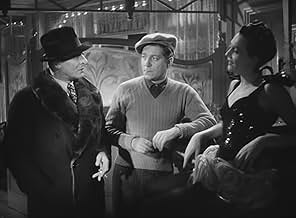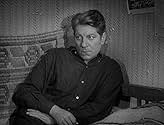VALUTAZIONE IMDb
7,7/10
8654
LA TUA VALUTAZIONE
Dopo aver commesso un omicidio, un uomo si chiude a chiave nel suo appartamento e ricorda gli eventi che lo hanno portato all'omicidio.Dopo aver commesso un omicidio, un uomo si chiude a chiave nel suo appartamento e ricorda gli eventi che lo hanno portato all'omicidio.Dopo aver commesso un omicidio, un uomo si chiude a chiave nel suo appartamento e ricorda gli eventi che lo hanno portato all'omicidio.
- Premi
- 1 candidatura in totale
René Génin
- Le concierge
- (as Genin)
Arthur Devère
- Mr. Gerbois
- (as Arthur Devere)
René Bergeron
- Le patron du café
- (as Bergeron)
Marcel Pérès
- Paulo
- (as Peres)
Annie Cariel
- Une locataire
- (non citato nei titoli originali)
Georges Douking
- L'aveugle
- (non citato nei titoli originali)
Georges Gosset
- Un agent
- (non citato nei titoli originali)
Recensioni in evidenza
the main setting of "le Jour Se Leve" is the top floor of a french apartment. the film opens with Jean Gabin character Francois - a factory worker- killing a dog trainer named Valentin who we find out (as the story unravels itself) was "involved" with his girl. Francois then barricades himself from the police, and the reason for the death of Valentin is told in simple sets of flashbacks that Gabin remembers between cigarettes as he decides what his next move will be. the story is simple and delicate in manner and substance but nonetheless the director/writer team Marcel Carne and Jacques Prevert succeed in turning the realistic (and sometimes edgy) conversations, movements and places into poetry. and in response to an earlier review, the simplicity of the flashbacks, is what makes the movie so intriguing. instead of relying on a heavy plot that might challenge audience, Prevert and Carne decide to put great detail into a simple tale about a sentimental man who is torn to ruin by a contemptuous and Machiavellian man.
We see a man shot; who he is and why we don't know. The murderer has locked himself inside his room. Police are forced to shoot in, trying to get him to surrender. The story then proceeds in flashback.
Marcel Carné directs this famous French film starring Jean Gabin. The two had worked together the previous year on "Le quai des brumes", a film well known then and now. If you are unfamiliar with Gabin, he was to the late 1930's in France what Bogey would be shortly in America, only Bogey with a soupçon of Cagney. More animated than Bogart, but less than Cagney with his agile song-and-dance-man side. A tough guy who's actually a good guy.
Now, a soft-hearted tough guy who's surrounded by police -- that could also describe Bogart's breakthrough film, "High Sierra", from 1941, and perhaps there is some superficial similarity.
However, this story is mostly a tale of love affairs and working class life -- that's really where its interest lies. There's a real sympathy here for the common man, when even a modest house on a rutted street would seem beyond his reach.
This film's original reputation may have been based at least in part on its Gallic openness about sexual matters. It's quite outré by the Anglo-Saxon standards of 1939. Regardless, the justly celebrated "Le jour se lève" has a poetic quality overall, and a memorably ironic final shot of the kind we don't seem to see quite often enough anymore.
Marcel Carné directs this famous French film starring Jean Gabin. The two had worked together the previous year on "Le quai des brumes", a film well known then and now. If you are unfamiliar with Gabin, he was to the late 1930's in France what Bogey would be shortly in America, only Bogey with a soupçon of Cagney. More animated than Bogart, but less than Cagney with his agile song-and-dance-man side. A tough guy who's actually a good guy.
Now, a soft-hearted tough guy who's surrounded by police -- that could also describe Bogart's breakthrough film, "High Sierra", from 1941, and perhaps there is some superficial similarity.
However, this story is mostly a tale of love affairs and working class life -- that's really where its interest lies. There's a real sympathy here for the common man, when even a modest house on a rutted street would seem beyond his reach.
This film's original reputation may have been based at least in part on its Gallic openness about sexual matters. It's quite outré by the Anglo-Saxon standards of 1939. Regardless, the justly celebrated "Le jour se lève" has a poetic quality overall, and a memorably ironic final shot of the kind we don't seem to see quite often enough anymore.
Thing that this movie is best known and appreciated for is its unique way of storytelling. It's one of the very first movies that features a story that gets mostly told with flashbacks and it keeps switching back between past and present. This storytelling technique was later made more famous and popular by Orson Welles with his masterpiece "Citizen Kane".
But of course a movie requires a bit more than just some good storytelling, though it still remains a very important aspect. But this movie also has a great, quite simplistic movie, with still a lot happening in it, like only the French could make. It's a bit of a sweet love-story, that shows the events leading up to a fatal shooting. Some people will call this movie slow but hey, that was just the way movies were back in its days. But it's not like it's slow pace ever makes the movie a boring or dragging one, or at least not to me. It might had been the case if the movie had been a bit longer but with its running time around 90 minutes, it's simply a short movie to watch.
It's also one beautiful looking movie, that features some great cinematography and especially lighting. Shadows play in important part in the movie its visual look. Amazing thing about its cinematography is that the movie actually had 4 different cinematographers attached to it. No idea what the story is behind this but I guess that each used their own specialty for this movie, or some of them simply got fired or stepped up during production. Anyway, whatever was the case, it really didn't hurt the movie its visual look. Marcel Carné movies often were visually a real pleasure to watch and this movie forms no exception on this.
It's also a movie that quite heavily relies on its actors to tell its story and to deliver its great dialog, that got specially written by poet scenarist and songwriter Jacques Prévert. And this movie luckily had some great actors to work with. At the time Jean Gabin really was one of the best French actors. He really did his best work in the '30's and starred in some other classics such as "Pépé le Moko" and "La grande illusion" during the same decade.
Some great and unique storytelling equals a great and unique movie.
9/10
http://bobafett1138.blogspot.com/
But of course a movie requires a bit more than just some good storytelling, though it still remains a very important aspect. But this movie also has a great, quite simplistic movie, with still a lot happening in it, like only the French could make. It's a bit of a sweet love-story, that shows the events leading up to a fatal shooting. Some people will call this movie slow but hey, that was just the way movies were back in its days. But it's not like it's slow pace ever makes the movie a boring or dragging one, or at least not to me. It might had been the case if the movie had been a bit longer but with its running time around 90 minutes, it's simply a short movie to watch.
It's also one beautiful looking movie, that features some great cinematography and especially lighting. Shadows play in important part in the movie its visual look. Amazing thing about its cinematography is that the movie actually had 4 different cinematographers attached to it. No idea what the story is behind this but I guess that each used their own specialty for this movie, or some of them simply got fired or stepped up during production. Anyway, whatever was the case, it really didn't hurt the movie its visual look. Marcel Carné movies often were visually a real pleasure to watch and this movie forms no exception on this.
It's also a movie that quite heavily relies on its actors to tell its story and to deliver its great dialog, that got specially written by poet scenarist and songwriter Jacques Prévert. And this movie luckily had some great actors to work with. At the time Jean Gabin really was one of the best French actors. He really did his best work in the '30's and starred in some other classics such as "Pépé le Moko" and "La grande illusion" during the same decade.
Some great and unique storytelling equals a great and unique movie.
9/10
http://bobafett1138.blogspot.com/
sentimental, far to be great, almost common. but seductive under the science of Carne to give delicate nuances to flash backs, to transform scenes in little gems. and, in same measure, the art of Prevert to transform each detail in a precise piece of puzzle. a film about love and innocence. about a kind of Mephisto - remarkable performance of Berry - and delicate lights of role in Jacqueline Laurent performance. but, in many aspects, a film of Arletty and Jean Gabin. not a surprise. the names of director and scriptwriter are basic guarantees for a remarkable work. but, after so many years, like many other films," Le jour se leve" has more seductive sparkles and great profound value.
Told in flashbacks, the story slowly enfolds to explain the death that started the movie. A very touching love story. The guy is just trying to find a little love in his daily struggle to work a dead end job and make ends meet. There is miscommunication between some couples. Characters are unsure about what it is they really want out of life. Events lead tragically to a death. Trapped in his room by the police, the crowd responds with varying degrees of sympathy and confusion. Was the death inevitable? Those are the questions. In the end, you understand how the situation could have ended differently. You will enjoy this movie.
Lo sapevi?
- QuizWhile not the first film to use dissolves to represent flashbacks, it was considered too new a method in the language of cinema that its producers' insisted on pre-title cards to avoid any confusion.
- Citazioni
M. Valentin: You're the type women fall in love with . . . I'm the type that interests them.
- ConnessioniFeatured in Un compositeur pour le cinéma: Maurice Jaubert (1985)
I più visti
Accedi per valutare e creare un elenco di titoli salvati per ottenere consigli personalizzati
- How long is Daybreak?Powered by Alexa
Dettagli
Botteghino
- Lordo Stati Uniti e Canada
- 35.321 USD
- Fine settimana di apertura Stati Uniti e Canada
- 11.864 USD
- 16 nov 2014
- Lordo in tutto il mondo
- 35.321 USD
- Tempo di esecuzione1 ora 33 minuti
- Colore
- Proporzioni
- 1.37 : 1
Contribuisci a questa pagina
Suggerisci una modifica o aggiungi i contenuti mancanti

Divario superiore
By what name was Alba tragica (1939) officially released in India in English?
Rispondi





























